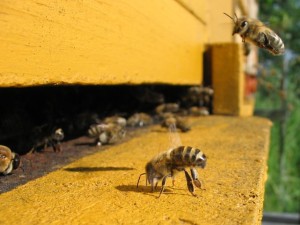Bee Smackdown: Conflicting Reports Claim Bees Are Bouncing Back And Collapsing
 A couple of articles have been making the rounds on Facebook this month, citing the same USDA reports to come to very different conclusions. One story is from the Washington Post, and it’s title says it all: “Call Off The Bee-pocalypse: Honeybee Colonies Hit A 20 Year High.” Meanwhile, a small paper in Ohio, the Telegraph-Forum, published “Bees Had A Rough 2015.”
A couple of articles have been making the rounds on Facebook this month, citing the same USDA reports to come to very different conclusions. One story is from the Washington Post, and it’s title says it all: “Call Off The Bee-pocalypse: Honeybee Colonies Hit A 20 Year High.” Meanwhile, a small paper in Ohio, the Telegraph-Forum, published “Bees Had A Rough 2015.”
Sifting through stories that pop up on your Facebook feed can be a wild ride, which is a way of saying that not all linked sites are equal in quality of journalistic efforts. But in this case, both are reputable papers. So this, I felt, required a little more digging.
Remember, both reporters cite the same report, the USDA honey report. So how did they come to such different conclusions?
Washington Post Reporter Christopher Ingraham zeroes in on the portion of the report that lists the number of colonies. He then went back through past years’ reports to create a graphic that shows that one stat, and sure enough, the number of colonies are at their highest since Colony Collapse Disorder (CCD) began in 2006. In fact, they’re higher than they’ve been in a while.
Ingraham is coming at CCD from a statistician’s point of view. If CCD wipes out 30% of bee populations year after year, then statistically, there should be almost no bee colonies left. So he does some digging and learns that bee keepers are doing everything they can to boost their hives. They are dividing healthy hives to create two smaller ones, and they’re buying in new bees, he reports. And since that strategy is working well, it’s time to call off the crisis.
But Telegraph-Forum Reporter Todd Hill — from a much more humble position of a small-town paper compared to Ingraham’s national paper — shows just why Ingraham’s final conclusion that concern for CCD is overblown is on wobbly legs.
The main headline of the USDA report is that U.S. honey production is down by 12% in 2015, and that’s what kicks off Hill’s article. He follows it up with showing that honey prices overall aren’t keeping up with lower production, so bee keepers are not earning as much money as they did in 2014.
If you put the two stories together, then what you can learn is that bee-keepers are spending more to get lower production from their hives. In this head-to-head reporting duel, I’d give the win to the Hill.










